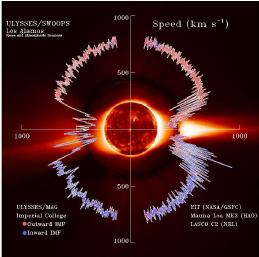 |
|
+ Home | ||

|
||||
| + Solar Cycle Prediction | + Magnetograph | + The Sun in Time | + The Hinode Mission | + The STEREO Mission |
The Solar Wind
|
The solar wind streams off of the Sun in all directions at speeds of about 400 km/s (about 1 million miles per hour). The source of the solar wind is the Sun's hot corona. The temperature of the corona is so high that the Sun's gravity cannot hold on to it. Although we understand why this happens we do not understand the details about how and where the coronal gases are accelerated to these high velocities. This question is related to the question of coronal heating. | |||
|
Solar Wind VariationsThe solar wind is not uniform. Although it is always directed away from the Sun, it changes speed and carries with it magnetic clouds, interacting regions where high speed wind catches up with slow speed wind, and composition variations. The solar wind speed is high (800 km/s) over coronal holes and low (300 km/s) over streamers. These high and low speed streams interact with each other and alternately pass by the Earth as the Sun rotates. These wind speed variations buffet the Earth's magnetic field and can produce storms in the Earth's magnetosphere. | ||
|
The Ulysses spacecraft completed two orbits through the solar system during which it passed over the Sun's south and north poles. Its measurements of the solar wind speed, magnetic field strength and direction, and composition have provided us with a new view of the solar wind. Ulysses was retired on June 30, 2009. | |||
|
The Advanced Composition Explorer (ACE) satellite was launched in August of 1997 and placed into an orbit about the L1 point between the Earth and the Sun. The L1 point is one of several points in space where the gravitational attraction of the Sun and Earth are equal and opposite. This particular point is located about 1.5 million km (1 million miles) from the Earth in the direction of the Sun. ACE has a number of instruments that monitor the solar wind and the spacecraft team provides real-time information on solar wind conditions at the spacecraft. | |||
